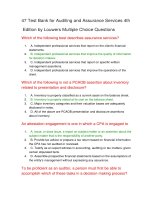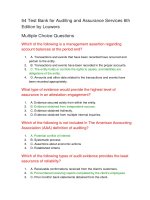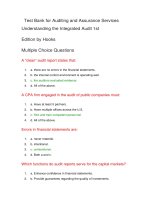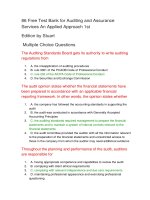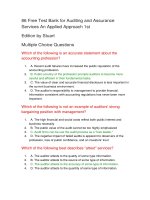Solution manual for auditing and assurance services an applied approach 1st edition by stuart
Bạn đang xem bản rút gọn của tài liệu. Xem và tải ngay bản đầy đủ của tài liệu tại đây (86.27 KB, 7 trang )
Full file at />CHAPTER 1 SOLUTIONS
What Is Auditing?
REVIEW QUESTIONS
1.
The corporate governance process is designed to protect outsiders from
misstatements in the financial statements. Auditors perform a unique role in this
process because they are hired to protect the interests of outsiders and to
determine whether the financial statements have been prepared in accordance with
the applicable financial reporting framework. Because auditors are independent
from management, outsiders are likely to receive more accurate information when
auditors review the financial statements prepared by management and issue an
opinion about whether the financial statements have been prepared in accordance
with the applicable financial reporting framework.
This role is more important today than 20 years ago. Companies are larger and
more complex than they were 20 years ago. The principal-agent problem
increases as the complexity of the business increases. The major frauds in the past
decade along with the Sarbanes-Oxley Act in the U.S. also make audit more
important today than 20 years ago.
2.
The auditor reviews information prepared by management (the financial
statements and the footnotes) to determine whether it conforms to a particular
standard (the applicable financial reporting framework). The person who
conducts the assessment follows a set of standards (generally accepted auditing
standards). The person completing the assessment is not an employee of the
company, but works for an accounting firm that is associated with the company
only in the role of being hired to perform an audit (a firm that is independent from
the company). The individual doing the assessment is hired to verify the fairness
and completeness of the decisions recorded by the firm so that outsiders have
accurate information to make decisions. The outsiders may be bankers, current or
potential stockholders, or regulatory bodies (outsiders to company management).
The accountants making the assessment provide a valuable, indeed, crucial,
service. Without such an assessment, outsiders would be forced to rely solely on
the information provided by the firm.
buy this full document at
Full file at />3.
4.
The relationship between management and the shareholders of a firm can be
described in the framework of a principal-agent relationship. The principals in
this relationship are the shareholders of the company. The agent is management.
A principal-agent relationship exists because the owners of the company (the
principals) are not involved in the daily management of the company. They hire
an agent (management) to run the company for them and to make daily decisions
for the company. This means that the owners of the company (the principals) are
removed from the daily operations of the company. Management has more
knowledge than the owners about the daily operations of the company. The
owners (the principals) would like management (the agent) to report correctly
what they know, so the principal hires an auditor to increase the likelihood of
correct reporting.
Three standard setting organizations are involved in establishing auditing
standards:
The Auditing Standards Board (ASB) of the American Institute of Certified Public
Accountants (AICPA);
The Public Company Accounting Oversight Board (PCAOB); and
The International Auditing and Assurance Standards Board (IAASB) of the
International Federation of Accountants (IFA).
The ASB writes auditing standards for non-public companies in the U.S. Many of
the standards of the ASB have been adopted as interim standards of the PCAOB.
The PCAOB writes auditing standards for public companies who list their stock
on the U.S. stock exchange.
The IAASB writes auditing standards for the international setting. These
standards can be adopted by any country.
5.
Audit evidence is the information used by the auditor to determine the audit
opinion issued. Audit evidence includes the information in the accounting
records, which includes the records of initial entries, supporting documents such
as checks, invoices, contracts, and the general and subsidiary ledgers of the
company. Management is responsible for the preparation of the financial
statements. The auditor is responsible for gathering sufficient (enough),
appropriate (relevant and reliable) evidence to determine that management has
prepared the financial statements in accordance with the applicable financial
reporting framework.
buy this full document at
Full file at />6.
The auditor performs internal control tests to determine if the control is working
(at the level expected) to prevent or detect misstatements in the financial
statements? If controls are not working, the auditor performs more substantive
tests.
7.
Substantive tests are performed by the auditor to answer the question: do the
financial statement accounts present fairly the financial condition of the firm in
accordance with the applicable financial reporting framework?
1. Substantive tests of transactions are done to gather evidence on income
statement accounts (revenue and expense accounts).
2. Substantive tests of balances are performed to gather evidence on balance
sheet accounts (assets, liabilities and owners’ equity).
3. Analytical procedures are calculations of financial ratios and comparisons of
last year’s audited financial statements with the current year’s unaudited
statements. They may be used to obtain evidence regarding income statement
accounts or account balances on the balance sheet.
8.
Classes of transactions are transactions for the year recorded in the income
statement accounts. They might also be referred to as transactions in the revenue
and expense accounts.
The auditor uses this concept to design tests to determine whether the income
statement accounts have been prepared in accordance with the financial reporting
framework used by company to prepare its financial statements.
9.
Tests of account balances are tests of the balance sheet accounts. The auditor uses
tests of account balances to determine that the balance sheet accounts have been
prepared in accordance with the applicable financial reporting framework at the
end of the year.
10.
When management presents the financial statements to the auditor, management
makes several assertions about the financial statements. These assertions are:
Financial statement assertions:
Existence or occurrence—for both classes of transactions and account balances
Completeness—for both classes of transactions and account balances
Valuation and allocation—for account balances
Rights and obligations—for account balances
Accuracy—for classes of transactions
Cutoff— for classes of transactions
Classification—for classes of transactions
Presentation and disclosure assertions
buy this full document at
Full file at /> Occurrence and rights and obligation — disclosed events and transactions have
occurred and pertain to the company.
buy this full document at
Full file at /> Completeness — all disclosures that should have been made have been made.
Classification and understandability — financial information is appropriately
presented and described. Disclosures are clearly expressed.
Accuracy and valuation — financial information and all other information is
disclosed fairly and at appropriate amounts
The auditor gathers evidence during the audit process to determine whether the
financial statements are prepared in accordance with the applicable financial
reporting framework organizing the evidence collection by management’s
assertions regarding the financial statements.
Both the ASB and the International Auditing Standards use these assertions. The
PCAOB uses the original five assertions (existence or occurrence, completeness,
valuation and allocation, rights and obligations, and presentation and disclosure),
but the PCAOB states that audit firms may use other assertions than the 5 they
have adopted.
11.
Paragraph 1 of the audit report describes the responsibilities of the auditor and
management. Paragraph 2 explains the work done by the auditor during the audit.
Paragraph 3 describes the conclusions reached by the auditor. In this or her
paragraph, the auditor gives his or her opinion on the financial statements.
12.
The Securities and Exchange Commission (SEC), the Financial Accounting
Standards Board (FASB), the American Institute of Certified Public Accountants
(AICPA) and the state accounting societies regulate the profession. The SEC
requires companies to file audited financial statements once per year. The FASB
writes accounting standards that make up the rules for the applicable financial
reporting framework in the U.S. The AICPA prepares the CPA exam and the Code
of Professional Conduct. State societies determine who can take the CPA exam
and the licensing requirements for a CPA.
13.
An interesting, exciting, and constantly changing profession. A profession with
licensing requirements for entry, a code of professional conduct to follow in the
practice of the profession, and continuing education requirements to remain a
member of the profession.
Many things might be appealing: the challenge, the range of potential jobs in the
profession, the fact that the profession requires specialized education and
experience to be a member.
Less appealing elements might include: stressful profession, standards constantly
changing, difficulty of entering the profession and many others.
buy this full document at
Full file at />14.
For public companies, management typically prefers higher net income to lower
net income. Net income can be increased by either reducing expense or
increasing revenue. Growth in revenue is also an important factor for many
companies. In this situation, managers try to show that revenue has increased
from last year, even if net income has not increased. The desired outcome in
many businesses is for revenue and possibly net income to increase at a rate at
least equal to the prior year’s increase, and if possible, greater than the prior
year’s increase. Outsiders, particularly stockholders expect this level of growth,
and if companies fail to meet these targets, their stock price may drop as investors
sell their stock and find other companies who can meet the growth level desired.
The principal reason to misstate financial statements is to keep the company’s
stock price from falling. Investors react unfavorably when companies report
lower revenue or net income numbers from the previous year.
The auditors challenge is to identify the material misstatements and to have them
corrected before the financial statements are issued.
REAL-WORLD AUDITING PROBLEMS
15.
Students might agree or disagree with whether it was fair for the entire
organization to be closed due to the felony conviction in 1 state in the U.S. The
key point in this question is for students to understand that an accounting firm
provides a service to the public. The value of this service is based on the
reputation of the firm. If this reputation is destroyed, the company has nothing of
value to offer outsiders.
INTERNET ASSIGNMENTS
16.
www.sec.org
www.pcaobus.org
www.aicpa.org
Outsiders might be interested in the information on the SEC and PCAOB website.
Accountants might be interested in the information on all the websites.
17.
www.generalmills.com
Under the investor link, you will find annual report information. They have a link
for corporate governance. KPMG is their auditor. They received a clean opinion
for the 2009 fiscal year.
18.
www.deloitte.com
www.kpmg.com
www.pwc.com
buy this full document at
Full file at />www.ey.com
All of these websites have information on careers in public accounting,
information about the company, services provided by the company, and industries
that they serve.
buy this full document at


